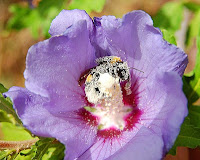As my explorations of history become more detailed, I find our misconceptions about history most interesting. Frequently, it seems to me, our misconceptions reveal as much about us as they reveal about the actual historical events.
Such is the case with the all so familiar phrase "red in tooth and claw." Today it is often used to evoke a picture of a "Darwinian" world of a predatory "survival of the fittest." So much so, that most people assume the phrase "red in tooth and claw" was inspired by Darwin's theory of evolution. In fact, that blood-tipped phrase predates
Origin of Species by nine years, having been penned by Alfred Lord Tennyson in his 1850 poem "In Memoriam." Moreover, Tennyson's poetic lament was prompted not by the death of any dinosaurs, but by the death of one of Tennyson's closest human friends.
Regardless of the origins of the phrase, more significant is what it conveys about our perceptions of Nature -- especially as we try to relate Nature to our human spirituality. Or as we aim to say whether we can discover a sacredness in the world of Nature.
 |
| Charles Darwin |
A parallel misconception about history lies behind the phrase "survival of the fittest," which most people assume to have been introduced by Charles Darwin in
Origin of Species. In fact, what Darwin used in the first edition of his book was the phrase "struggle for existence," which does not sound as competitive. Even that phrase was already in circulation -- but for describing
human society. In Britain during the first half of the 19th century, industrialization and migration to the cities had increased social strife. Darwin employed that firsthand experience of a human "struggle for existence" in order to make his explanation for the evolution of other species of life more understandable.
(I do sometimes wonder what animals might think if they could know all the human projections we place upon them.)
 |
bee covered with pollen
in hibiscus flower |
Today, our vastly increasing knowledge from the science of ecology reveals how evolution has occurred not just through competition but also through all sorts of mutually beneficial relationships. True, there is an ambiguity in Nature, in that the death of the prey means life to the predator. And it is also true that there is an element of chance in biological evolution (just as there is in human life). However, one teacher of biology tells me that because of all the ways birds and insects pollinate plants as they gather food, there are more cooperative relationships than there are competitive relationships in Nature.
Nature as a whole is strongly self-sustaining. So much so that we might borrow the word "green" from the environmental movement to say that Nature is green in tooth and claw!
~~~
Where do you see relationships in the non-human realm of Nature?
(The drawing of Darwin is in the public domain
in the U.S. because it is over 70 years old.)
(The flower photograph, by Luc Viatour, is used under terms of GNU Free Documentation License.)


2 comments:
Is there any place we look in Nature where there are not relationships? How could that even be?
It's true that there is much cooperation in the natural world and many mutualisms that sustain life. However predation and competition can be life-giving as well.
In ecology, interaction networks (such as food webs) are notoriously fickle and unstable. The result of this is that over long time scales they often undergo large "boom and bust" periods that end up wiping out populations, not only of predator and prey, but also all the companion species with cooperative interactions. One of the most effective ways to keep these ecological networks stable is to have certain types of competition or predation amongst the critters. Therefore, nature in its "redness" can actually maintain higher diversity and richness of species.
Post a Comment